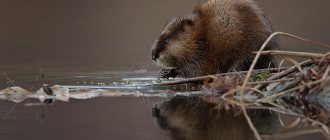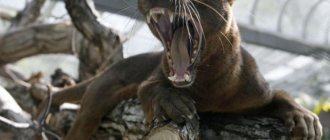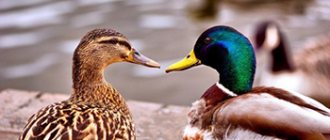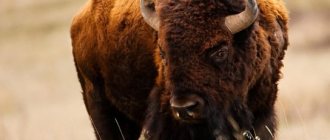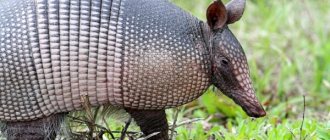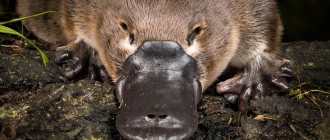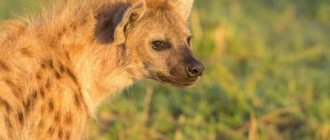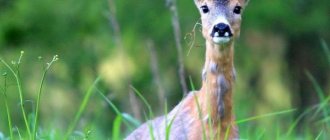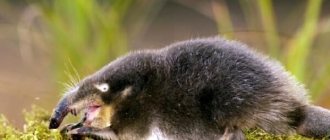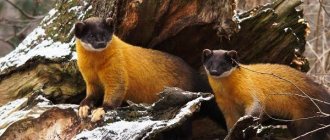- Where does the walrus live?
The very name of this animal has become a household word; walruses are sometimes called people who are not afraid of the cold, who are able to swim in an ice hole in winter, and so on. As for real walruses, these amazing animals are interesting not only because they are not afraid of the cold, living in cold Arctic regions, but also because walruses are the largest pinnipeds living in the northern hemisphere of our planet. Only the southern sea walrus is larger than walruses
an elephant related to walruses - seals, but it lives in Antarctica. And today’s heroes of our article, walruses, are, without exaggeration, the true giants of the Arctic.
Description, structure, characteristics
According to the zoological classification, all walruses belong to the family of walruses, the order of pinnipeds, that is, those with flippers instead of legs.
The size of a walrus, if it is a male, is on average 3-4.5 meters in length, female walruses are slightly smaller - they are 2.6-3.6 meters in length. The weight of a male walrus is 1.5-1.8 tons, females are slightly lighter, they weigh “only” 700-800 kg.
Externally, walruses are also somewhat similar to their relatives - eared seals. The body of the walrus, although very massive, is nevertheless distinguished by unexpected plasticity and mobility. The hind legs of a walrus are capable of bending at the heel joint, can bend under the body and take part in the movement of these animals.
But the main difference between walruses, both from other pinnipeds and other animals in general, their “signature calling card” is, of course, a pair of long fangs or tusks protruding from the upper jaw towards the ground.
Walrus tusks.
In females, the length of the fangs-tusks is on average 30-40 cm, while in males they can reach up to 80 cm. Why does a walrus need tusks? In fact, their tusks serve them for various practical purposes, primarily for self-defense from potential predators and to sort things out among themselves - male walruses sometimes quarrel with each other over females, and then their tusks are used. Walruses can also climb onto ice floes with the help of their tusks.
In addition to the fangs-tusks, walruses have sensitive hair on their face - vibrissae; the thickness of the vibrissae of an adult walrus is approximately the same as that of a wire.
The vision of walruses is poorly developed, but this deficiency is more than compensated by an excellent sense of smell, so walruses can easily smell, among other things, the smell of a person, retreating before he approaches.
The skin of the walrus is thick and rough, with insignificant rudiments of fur; in fact, the whiskers are the only hair on the body of walruses. The color of walruses is brown, but in older individuals sometimes pinkish spots on the skin are noticeable - these are traces of numerous scars and scratches acquired during the turbulent life of a walrus.
Description and features
The sea animal is impressive in size. Most walruses are 3.5 meters long, but there are individuals that reach 5 meters. Females are inferior - 2.7-3.7 m. The weight of giants is 1.5-2 tons. A female walrus is one third lighter than a male. In terms of weight, sea lions living in Antarctica compete with walruses.
Massive animal carcasses are covered with wrinkled skin with brown hairs. Gradually they disappear, the old individuals are completely “naked”. The thickness of the skin is 4-8 cm, the fat layer underneath is up to 15 cm. The tail has rudimentary shapes.
The brown color of young individuals gradually lightens, and towards old age a pink tint appears. The white walrus is not a separate subspecies, but a temporary state of the animal when, when swimming in ice water, the blood vessels under the skin narrow, which results in maximum lightening of the integument.
Despite their large mass, walruses are flexible. The callused flippers are flexible. The hind limbs are mobile, so the animal moves confidently. Walruses can walk, unlike crawling seals.
The animals' well-developed downward fangs are noteworthy. Each weight is almost 3-4 kg, 60-80 cm long. The walrus tusk plays a social role - the owners of the largest pair dominate the group. Practical application is manifested in battles with enemies and rivals. Reliance on the fangs helps animals get to the surface from the ice hole and form holes in the ice floes.
The walrus's muzzle is covered with whiskers. There are up to 700 bristles on the upper lip alone. High sensitivity of hair helps walruses find underwater mollusks.
Animals' eyes do not have sharp vision. An excellent sense of smell helps to navigate well in the water. There are no auricles. Special throat bags allow the giant to turn into a float to stay on the surface of the reservoir. Filled with air, they inflate like balls and hold the animal during sleep. The throat sacs are partially involved in the production of sounds.
The life of walruses, resistant to the harsh conditions of the Arctic, is associated with minor migrations. With the onset of winter, they move from northern latitudes to the southern coast of Alaska, to the Kamchatka Peninsula.
Animal populations for the northern expanses are negligible. There is no point in doubting whether the walrus is in the Red Book or not . Mortality rates from poaching remain high. Commercial hunting of animals for skin, meat, fat, and fangs has long been prohibited.
Fishing to a limited extent is permitted exclusively to indigenous peoples who live off the harvest of this species. In the vast Arctic expanses, in addition to humans, the giant mammal has natural enemies - polar bears and killer whales.
The victims of polar bears are weakened individuals or baby walruses that find themselves on land unattended. In the sea elements it will be more difficult for a bear to cope with them. Even a hungry animal will not risk attacking a strong walrus, lest it itself become a victim in the fight.
Bears often use cunning to defeat the mighty walrus. So, they sometimes sow panic in order to identify weak and crippled individuals for easy profit. If the animals calmly leave the rookery, then the bears will be left without tasty prey. When walruses rush towards a white predator, it can retreat with dissatisfaction, knowing that wounds from sea giants are fatal.
An even more sophisticated method was observed by the Eskimos. The bear's ingenuity manifested itself in the fact that he found a sleeping walrus and threw a block of ice on his head. It was not difficult for the predator to deal with the prey.
On the Internet you can find a photo of a walrus lying peacefully near a polar bear. Well-fed animals do not show aggression; they prefer to watch strong rivals until the right opportunity.
Killer whales, which exceed them in mass and size, pose a serious threat to walruses. Strong jaws and sharp teeth are stronger than powerful fangs. Pods of killer whales crash into the stream of walruses to break it into pieces, after which they attack the surrounded animals in an organized manner. The walrus can only escape by fleeing to land.
Nutrition
Walruses' favorite delicacies include sea worms, mollusks and crustaceans. With its powerful tusks, the walrus pierces the muddy bottom and picks up many shells from there, their shells are erased by flippers, and the mollusks themselves are eaten by walruses. The same thing happens with worms and crustaceans, which walruses literally sweep from the seabed to then eat. To be satiated, an adult walrus needs to eat at least 50 kg of food per day.
Walruses eat fish, but less readily than mollusks or worms; walruses may resort to hunting fish as a last resort, when there is no other food for them.
What role do tusks play in the life of a walrus?
Walrus tusks are modified fangs of the upper jaw. They grow in individuals of both sexes, but the tusks of males are usually much longer and thicker. The growth of fangs begins in cubs from 5-6 months, by the time they are one year old their length reaches 10 cm, and by the time of puberty - 70-80 cm. The maximum recorded sizes of the fangs of an adult male are: length - 1 m, diameter - 8 cm, weight - 5.5 kg.
In walruses, tusks perform several functions:
- Using sharp and strong teeth, the animal fights off predators that attack it.
- With elongated teeth, walruses loosen the soil at the bottom of the ocean, then selecting mollusks and crustaceans from it.
- Walruses often use their upper tusks as an ice axe, cutting holes in the ice to descend to the bottom in search of food. The tusks help the clumsy and massive pinnipeds move on the ice and get out of the water onto the shore.
- Observations of the behavior of groups of walruses showed that males with the most massive and longest tusks manage to achieve a higher status in the hierarchy.
Enemies in nature
In turn, the walrus itself can become prey for killer whales at sea, white
on bearish land, and their third enemy (in any element) is, of course, man. The indigenous peoples of the North: the Chukchi and Eskimos, from ancient times hunted walruses (as well as seals), but they never killed more of them than they needed for food. The white man changed everything - the barbaric extermination of walruses by hunters and poachers in the last and century before last, carried out for the sake of their tusks, led to the fact that in our time the walrus population has greatly decreased and now these giants of the Arctic are listed in the Red Book, as they are brink of extinction.
What benefits do walruses bring?
Walruses have always been of great importance to the indigenous peoples of the Far North. The carcasses of killed walruses were used in full, providing residents of the northern coasts with protein-rich meat, skins for building houses and covering boats, and fat for heating and lighting. Walrus tusk served as a material for the manufacture of weapons, tools and decorative items.
Pinnipeds play an important role in the ecosystem: young, old and weakened individuals become food for killer whales, polar bears and those who follow them in search of remains of polar fox carcasses.
HIPPOPOTAMUS
Lifestyle
Walruses are herd animals and usually gather in small herds of 20-30 individuals, but at times they can create large rookeries of up to 3000 individuals. In a herd of walruses, the strongest male usually dominates; the remaining males periodically sort things out with him and with each other, but the main subject of dispute among male walruses is, of course, the females. But disputes and even fights for females between males occur exclusively during the mating season; the rest of the time, all walruses are very peaceful animals.
It is interesting that sentinels are located along the edges of walrus rookeries; having noticed the danger, they notify their fellows with a loud roar, after which the entire herd rushes into the water. Like seals, all walruses are excellent swimmers, capable of spending whole days in the water.
Lifestyle and habitat
The life of sea animals is fundamentally connected with the northern coasts of Europe, North America, Asia, and the Arctic islands. They encircle the North Pole in a ring, staying close to the coast, avoiding open water spaces and multi-year ice.
The walrus lives in shallow waters, a comfortable environment for pinniped mammals. The habitat of walruses is currently divided into separate areas due to a decline in numbers. Seasonal migrations to the south are insignificant and short.
The walrus is a herd animal. Mammals form small colonies of 10-20 individuals of different sexes. There is no strict hierarchy in the groups; all members of the herd behave evenly. Experienced males calmly treat young animals without showing aggression.
Large rookeries consist of groups of animals of several hundred, sometimes thousands of walruses. The animals are located close to each other. Crowding is created deliberately, and not due to lack of space. The live mass moves due to the movements of animals to water and back. Individuals behave, in general, peacefully, although isolated skirmishes also occur.
The rest of the rookery is protected by shift guards. Although the eyesight fails the animals, the sense of smell will always give a signal of the approach of a person. They announce the threat by roaring and pushing each other.
The flight of huge carcasses to the water sometimes ends with the death of babies among the obese bodies. The cubs who managed to climb onto the backs of their mothers are saved. Sometimes panic turns out to be stronger than the organization of the herd. Mutilated victims turn out to be easy prey for polar bears. Walruses hide underwater, where they can remain without air for up to 10 minutes, but are ready to swim all day.
Animals alternate being in the sea with being on land, where they rest lying down near the water's edge. They climb onto flat ice floes, leaning on their powerful tusks. They can sleep anywhere, being unsinkable due to a thick layer of fat. Animals move and hunt as a herd. Sociability manifests itself in support and helping other individuals.
Types, photos and names
Zoologists distinguish only three subspecies of walruses, and below we will describe them in more detail.
Pacific walrus
The Pacific walrus is the largest walrus in the world, the male is 3.5-4.5 m long and weighs up to two tons. Females are slightly smaller. It lives in the northern part of the Far East - along the shores of the Bering Strait, in the Chukchi and Bering Seas and off the Kamchatka islands.
Atlantic walrus
This species is slightly smaller than its Pacific counterpart, its average length is 2.5-3 meters, females are several times smaller. It lives in the Kara Sea, the Barents Sea, on Franz Josef Land in the Arctic Ocean.
Laptev walrus
This species of walrus is the smallest and is currently endangered. It lives in the Central and Western parts of the Laptev Sea, in the eastern part of the Kara Sea and in the West of the East Siberian Sea. In terms of size, bast walruses occupy an intermediate state between the Pacific and Atlantic walruses.
Where do they live?
Walrus colonies are found in Arctic and subarctic waters. Habitat: coastal zones of the Arctic Ocean.
Where live
The natural habitat of the walrus is ice-covered areas near the coasts of Europe, Asia, North America, and Arctic islands with a depth to the bottom of 100-150 m. Pinnipeds do not settle near vast unfrozen water spaces and do not establish rookeries on pack ice.
Walruses are characterized by seasonal migrations. In the fall they move to the ice areas of the Bering Sea, and in the spring they return to their usual habitats in the Chukchi Sea. Males and females of the Pacific subspecies can cover up to 3,000 km during migration, moving by swimming and on drifting ice floes, while females with cubs swim further than males.
There is no detailed and reliable information about the migrations of Atlantic walruses due to a significant reduction in the size of this population. Presumably, they do not make such long journeys as their relatives.
Reproduction
Walruses reach sexual maturity at the age of five, and their mating season occurs in April-May; it is during this period that previously peaceful males become very aggressive and every now and then fight with each other (with the help of fangs-tusks, of course) for females. They, as expected, choose the strongest males as their sexual partners.
The pregnancy of a walrus lasts 340-370 days and only one calf is born at a time. In very rare cases, twins may be born. Little walruses are not so small - their body length is about 1 m and their weight is 30 kg. From the first days of life they learn to swim. For the first year of life, small walruses are breastfed, and only after a year they become able to eat food from adult walruses.
All walruses have a developed maternal instinct, they selflessly protect their cubs in case of danger, and in general are caring mothers. Until the age of three, while the young walrus has not yet grown its tusks, it stays next to its mother, and only after reaching the age of three, with already grown tusks, does it begin adult life.
Walrus: description, photo
Walruses have formed three populations in the world. There is a Pacific walrus, an Atlantic subspecies and inhabitants of the Laptev Sea. Their external differences are not significant. The main difference remains the main habitat.
Walruses: appearance
Who is a walrus? This is a large pinniped mammal:
- from 2 to 3.5 m in length;
- with a weight of 800–2000 kg in males and 500–800 kg in females.
The walrus has thick, wrinkled skin about 10 cm thick, under which there is a 15 cm layer of fat. Males are distinguished by large skin growths in the neck and shoulders. Juveniles are dark brown in color, with age the skin becomes pale with a pinkish tint.
Photo: pixabay.com: UGC
On the wide muzzle, hard, thick antennae and bristles are noticeable. The eyes are not large, there is only an inner ear. The tail is small. Walruses have well-developed forelimbs - flippers, which allow the animal to move along the surface of the earth.
An indispensable attribute of both males and females are tusks. In the former they are always much larger, sometimes reaching 1 m in length. This is due to fights with other males and the struggle for a dominant position. In addition, with the help of their tusks, these pinnipeds break through ice and stay on its surface.
Walruses: lifestyle, behavior
Despite its menacing appearance, the walrus is a sociable and friendly animal. This applies to relationships within the herd. In the formed group, joint protection of the offspring is carried out. There are always sentries “on duty” around the rookery.
If they happen to spot a polar bear or a person, they roar loudly and give a signal to their relatives to hide under water. In dangerous situations, walruses prefer not to attack, but to avoid conflict, although they have remarkable strength.
Photo: pixabay.com: UGC
Adult male walruses display their fighting qualities only during the mating season. They become very aggressive and attack each other in the fight for females. As soon as mating ends, peaceful life reigns in the herd again.
Interesting Facts
Rookeries
Walrus rookeries are a very interesting sight. There are a huge number of bodies lying on the stones, pressed tightly against each other. Some individuals crawl into the water, while others return to the rookery. In such a huge mass, both individual skirmishes and friendships are formed.
The peace of the rookery is guarded by shift sentries. In case of danger, the sentries roar, and massive carcasses instantly rush into the water. Children can die in such crushes. But more often the mother manages to save her offspring by covering them with her strong body. Walruses establish rookeries not only on land, but also on ice floes. Pack ice is not suitable for these purposes; only females give birth to offspring on it.
Video
And in conclusion, we bring to your attention an interesting documentary film about walruses filmed by the team of the famous Captain Cousteau - “The Smile of the Walrus”.
Author: Pavel Chaika, editor-in-chief of Poznavaika magazine
When writing the article, I tried to make it as interesting, useful and high-quality as possible. I would be grateful for any feedback and constructive criticism in the form of comments on the article. You can also write your wish/question/suggestion to my email pav [email protected] or on Facebook, with respect, the author.
Author page
What do walruses eat?
The main menu consists of elasmobranchs and other benthic invertebrates.
Less commonly, pinnipeds can feast on fish. Sometimes there are cases of hunting seals, seals or eating carrion.
The daily food volume of an adult is up to 80 kg.
To obtain food, the walrus is capable of diving under water for a long time.
The animal obtains mollusks and other bottom living creatures with its fangs. In captivity, tusks break on the bottom of artificial pools.
Walrus hunting
Walrus hunting is a traditional trade for the northern peoples: Chukchi, Eskimos, and so on. Hunters use all parts of the animal on the farm : skin, fat, meat, tusks and bones, entrails.
Today, walrus hunting is under strict control of the countries where these animals live. Northern peoples are given a special quota for hunting animals, since its meat is an integral part of their diet.
Commercial hunting of walruses is prohibited worldwide . Canada, the USA, Russia and Denmark are taking all measures to preserve walrus populations in the wild.
Why do walruses need tusks?
During evolution, the upper canines of these pinnipeds acquired the shape of tusks. Both females and males have tusks. Animals use them both as a weapon in a fight and as a tool for breaking through ice. However, their main purpose is to demonstrate the social status of a particular individual. In any gathering of walruses, a larger individual with massive tusks strives to occupy a dominant position. Simply by demonstrating the size of its tusks, an animal can take a more comfortable or advantageous position among its fellows with more modest fangs. If a dominant male encounters an opponent with fangs roughly equal in size to his own, their confrontation may escalate from threats to fighting until one of the opponents gives up and retreats from the battlefield. Males fight most actively during the breeding season, but skirmishes also often occur between females.
